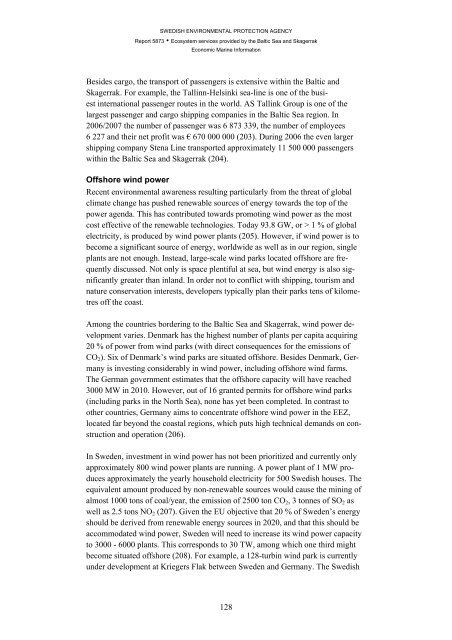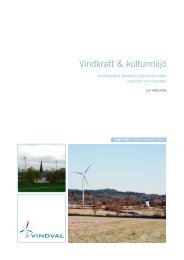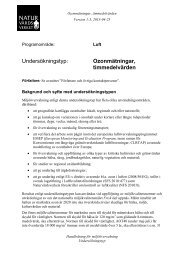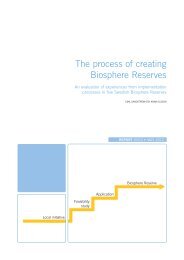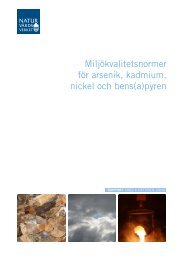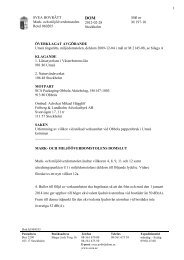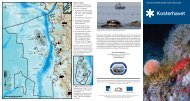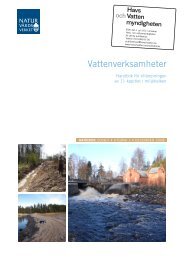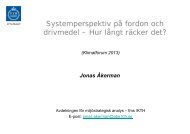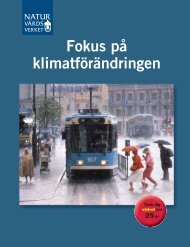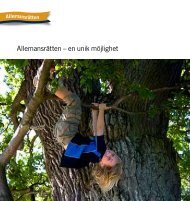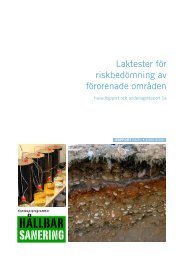Ecosystem services provided by the Baltic Sea ... - Naturvårdsverket
Ecosystem services provided by the Baltic Sea ... - Naturvårdsverket
Ecosystem services provided by the Baltic Sea ... - Naturvårdsverket
Create successful ePaper yourself
Turn your PDF publications into a flip-book with our unique Google optimized e-Paper software.
SWEDISH ENVIRONMENTAL PROTECTION AGENCY<br />
Report 5873 • <strong>Ecosystem</strong> <strong>services</strong> <strong>provided</strong> <strong>by</strong> <strong>the</strong> <strong>Baltic</strong> <strong>Sea</strong> and Skagerrak<br />
Economic Marine Information<br />
Besides cargo, <strong>the</strong> transport of passengers is extensive within <strong>the</strong> <strong>Baltic</strong> and<br />
Skagerrak. For example, <strong>the</strong> Tallinn-Helsinki sea-line is one of <strong>the</strong> busiest<br />
international passenger routes in <strong>the</strong> world. AS Tallink Group is one of <strong>the</strong><br />
largest passenger and cargo shipping companies in <strong>the</strong> <strong>Baltic</strong> <strong>Sea</strong> region. In<br />
2006/2007 <strong>the</strong> number of passenger was 6 873 339, <strong>the</strong> number of employees<br />
6 227 and <strong>the</strong>ir net profit was € 670 000 000 (203). During 2006 <strong>the</strong> even larger<br />
shipping company Stena Line transported approximately 11 500 000 passengers<br />
within <strong>the</strong> <strong>Baltic</strong> <strong>Sea</strong> and Skagerrak (204).<br />
Offshore wind power<br />
Recent environmental awareness resulting particularly from <strong>the</strong> threat of global<br />
climate change has pushed renewable sources of energy towards <strong>the</strong> top of <strong>the</strong><br />
power agenda. This has contributed towards promoting wind power as <strong>the</strong> most<br />
cost effective of <strong>the</strong> renewable technologies. Today 93.8 GW, or > 1 % of global<br />
electricity, is produced <strong>by</strong> wind power plants (205). However, if wind power is to<br />
become a significant source of energy, worldwide as well as in our region, single<br />
plants are not enough. Instead, large-scale wind parks located offshore are frequently<br />
discussed. Not only is space plentiful at sea, but wind energy is also significantly<br />
greater than inland. In order not to conflict with shipping, tourism and<br />
nature conservation interests, developers typically plan <strong>the</strong>ir parks tens of kilometres<br />
off <strong>the</strong> coast.<br />
Among <strong>the</strong> countries bordering to <strong>the</strong> <strong>Baltic</strong> <strong>Sea</strong> and Skagerrak, wind power development<br />
varies. Denmark has <strong>the</strong> highest number of plants per capita acquiring<br />
20 % of power from wind parks (with direct consequences for <strong>the</strong> emissions of<br />
CO 2 ). Six of Denmark’s wind parks are situated offshore. Besides Denmark, Germany<br />
is investing considerably in wind power, including offshore wind farms.<br />
The German government estimates that <strong>the</strong> offshore capacity will have reached<br />
3000 MW in 2010. However, out of 16 granted permits for offshore wind parks<br />
(including parks in <strong>the</strong> North <strong>Sea</strong>), none has yet been completed. In contrast to<br />
o<strong>the</strong>r countries, Germany aims to concentrate offshore wind power in <strong>the</strong> EEZ,<br />
located far beyond <strong>the</strong> coastal regions, which puts high technical demands on construction<br />
and operation (206).<br />
In Sweden, investment in wind power has not been prioritized and currently only<br />
approximately 800 wind power plants are running. A power plant of 1 MW produces<br />
approximately <strong>the</strong> yearly household electricity for 500 Swedish houses. The<br />
equivalent amount produced <strong>by</strong> non-renewable sources would cause <strong>the</strong> mining of<br />
almost 1000 tons of coal/year, <strong>the</strong> emission of 2500 ton CO 2 , 3 tonnes of SO 2 as<br />
well as 2.5 tons NO 2 (207). Given <strong>the</strong> EU objective that 20 % of Sweden’s energy<br />
should be derived from renewable energy sources in 2020, and that this should be<br />
accommodated wind power, Sweden will need to increase its wind power capacity<br />
to 3000 - 6000 plants. This corresponds to 30 TW, among which one third might<br />
become situated offshore (208). For example, a 128-turbin wind park is currently<br />
under development at Kriegers Flak between Sweden and Germany. The Swedish<br />
128


